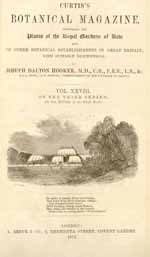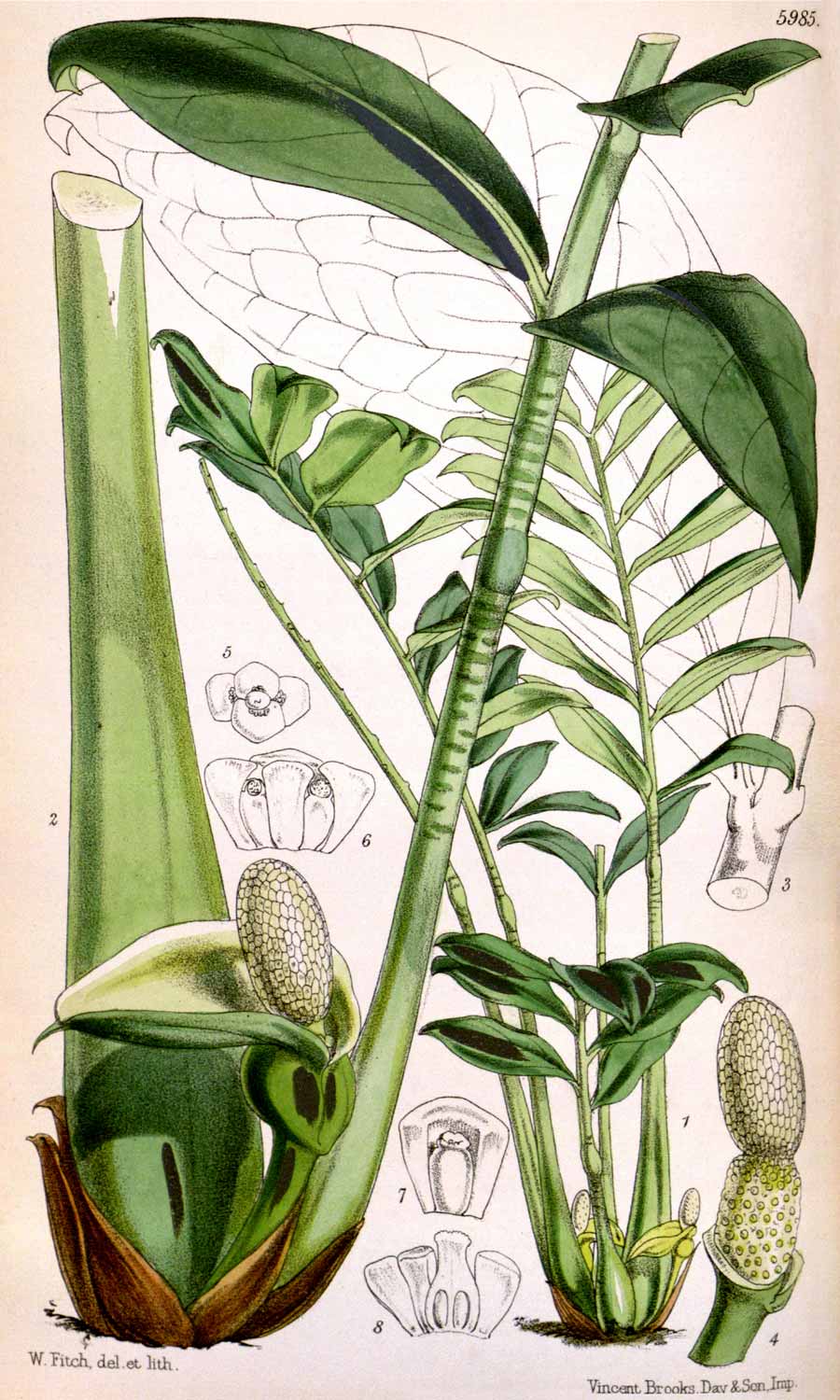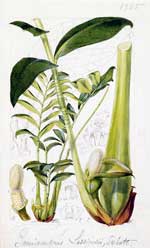Zamioculcas Loddigesii
(Synonym of
Zamioculcas zamiifolia)
Text page
by Joseph Dalton Hooker

|
Joseph Dalton Hooker (text) and Walter Hood Fitch (plate): Zamioculcas Loddigesii.
Tab. 5985 from Curtis's Botanical Magazine, Third Series, Vol. 28 (1872)
Tab. 5985.
ZAMIOCULCAS LODDIGESII.
Native of East Tropical Africa.
—————————
Nat. Ord. AROIDEÆ.—Tribe, ORONTIEÆ.
Genus ZAMIOCULCAS, Decne. in Bull. Soc. Bot.
France, vol. xvii. p. 321.
——————————————
ZAMIOCULCAS Loddigesii ;
foliis imparipinnatis,
foliolis 6–8-jugis alternis elliptico v. obovato-lanceolatis
acutis brevissime petiolulatis v. sessilibus, nervis laxe
reticulatis, petiolo tereti basi clavato infra foliola
nodoso-incrassato, scapo perbrevi, spathæ tubo subgloboso
lamina cymbiformi dorso infra apicem cornuta.
ZAMIOCULCAS Loddigesii, Schott. Prodr. Syst. Aroid. p. 214 ; Decaisne in Bull. Soc. Bot. France, vol. xvii p. 322.
CALADIUM zamiæfolium, Loddiges' Bot. Cabinet, t. 1408.
——————————————
Decaisne has well remarked of this most curious
genus, in a letter addressed to the President of the Botanical
Society of France, that it is not only singular in the family of
plants to which it belongs, but in the whole class of
Monocotyledons, in having a genuine pinnated leaf, with
articulated caducous leaflets, as in various Dicotyledons. To
this peculiarity may be added the singular clavate form of the
base of the petiole, and the thickened false articulation, like
that of a Marattia frond, about halfway between the lowest
pinnule and base of the petiole. M. Decaisne describes the
flowers in the lower half of the spadix as female and of the
upper as male ; in the plant I find both stamens and pistils
throughout the spadix, but the stamens appear perfect only on the
lower half and the pistils on the upper ; furthermore, whilst
the pistils of the lower half are flaggon-shaped, with a short
style, and a basal anatropous or campylotropous ovule in each
cell, those in the upper half having oblong ovaries, with sessile
stigmas, sunk below the tips of the perianth-segments (hence
concealed), and
ovules adnate almost throughout their length to the septum.
The genus Zamioculcas is confined to eastern
tropical Africa. Z. Loddigesii was introduced into the
Horticultural Garden before 1828, probably by Forbes, and figured
with a most imperfect description, by Loddiges, who supposed it
to be a native of Brazil. Nothing more was known of it till it
was introduced from Zanzibar into the Jardin des Plantes at
Paris, where it flowered in 1869, and was subsequently described
and published by M. Decaisne, together with another, also
Zanzibar, species, Z. Boivinii, which exists in the Paris
Herbarium and has bipinnate leaves. Our plants were received
from that indefatigable naturalist Dr. Kirk, F.L.S., now H.B.M.
V.-Consul at Zanzibar in 1870, and flowered in June, 1872.
Rhizome short ; horizontal, giving off large
white sessile tubers, the size of a potato, from the crown of
which proceed very stout fleshy simple fibres. Leaves all
radical, springing from the axil of an ovate-lanceolate brown
membranous sheath that soon withers ; petiole about two feet
long, terete, clavate at the base, with a thickened false
articulation some way below the leaflets, green, faintly marked
with darker transverse bars ; leaflets six to eight pairs, three
to six inches lomg, alternate, deciduous, the uppermost sometimes
appearing terminal, as if the leaf were imparipinnate, obovate-
or elliptic-lanceolate, acute or acuminate, subsessile or shortly
petioled, bright green and shining above, nerves laxly
reticulated, pale beneath ; midrib stout. Scape very short,
stout. Spathe green, thick, lower part embracing the lower half
of the spadix, blade about two inches long, boat shaped, with a
dorsal horn below the apex. Spadix one and a half to two inches
long, stout, cylindric, obtuse, constricted at the middle.
Flowers most densely crowded. Perianth-segments cubical or
cuneate, very thick, concave in front and closely embracing the
pistil. Stamens with subclavate flattened filaments and minute
anthers that burst by longitudinal slits.—J. D. H.
——————————————
Fig. 1, Plant :—reduced ;
2, portion of ditto:—natural size ; 3, portion of petiole
and leaflet ; 4, spadix ;
5, flower from lower part of the spadix ; 6, vertical section
of young ditto ; 7, perianth, leaflet, and ovary of ditto ; 8,
vertical section of female flower and perianth :—all magnified.
August 1st, 1872.
|

Curtis's Botanical Magazine
Title Page of Vol. XXVIII. of the Third Series or Vol. XCVIII. of the Whole Work (1872)
© Missouri Botanical Garden
|




